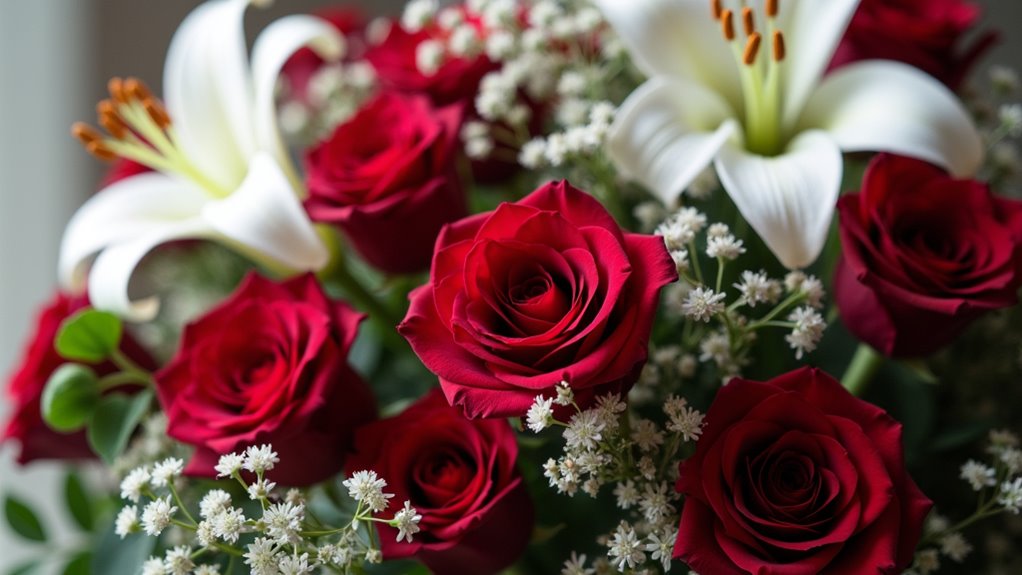Imagine giving a bouquet of red roses to someone you care about deeply, only to discover later that their favorite flower also symbolizes secret admiration. Flowers speak in ways words often can’t, carrying messages that go beyond their beauty. Whether for a special occasion or a simple gesture, understanding these hidden meanings can make your floral gift truly meaningful. Discover how each bloom’s symbolism can help you communicate what matters most.
Key Takeaways
- Different flowers and their colors carry specific cultural and emotional meanings, allowing you to convey personalized messages through bouquets.
- Roses symbolize love and admiration, with color variations indicating romance, friendship, gratitude, or purity.
- Lilies are associated with purity, innocence, and spirituality across cultures and religions, enhancing their symbolic significance.
- Bright tulips and sunflowers communicate hope, positivity, and loyalty, making them ideal for uplifting or heartfelt gestures.
- Daisies and forget-me-nots represent innocence, new beginnings, and remembrance, emphasizing themes of purity and enduring love.
The Language of Roses: Expressing Love and Admiration
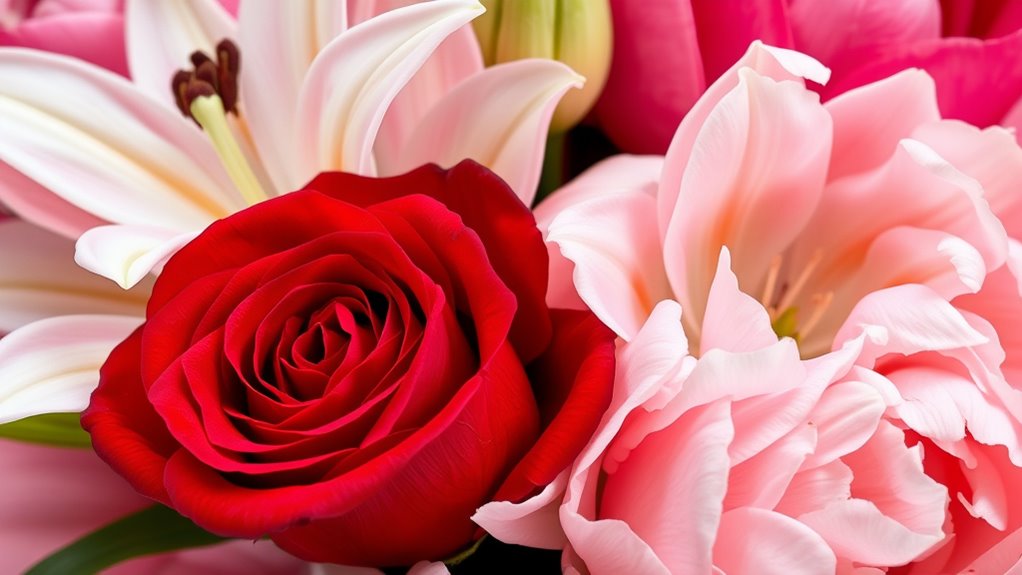
Roses have long symbolized love and admiration, making them a popular choice for expressing your deepest feelings. When you create a flower arrangement or gift a bouquet, the symbolism behind roses speaks volumes. Red roses, in particular, are iconic for romance and passion, conveying heartfelt affection. A carefully chosen bouquet can also reflect admiration or respect through different rose colors—white for purity, yellow for friendship, or pink for gratitude. By understanding bouquet symbolism, you guarantee your gesture truly resonates. Your selection of roses communicates more than words ever could, turning a simple flower arrangement into a powerful message of love and appreciation. When you choose roses thoughtfully, you share meaningful emotions effortlessly and beautifully. Additionally, color accuracy in the presentation of your bouquet ensures that the intended message is conveyed clearly and vividly.
Lilies and Their Symbolic Significance in Different Cultures

Lilies carry rich meanings across cultures, from Western traditions to Asian beliefs. You’ll find they symbolize purity, renewal, or even mourning depending on the context. Exploring their religious and cultural significance reveals how deeply these flowers resonate worldwide. Additionally, the interior design principles such as creating captivating narratives can help convey these symbolic meanings effectively in floral arrangements.
Western Symbolism of Lilies
In Western cultures, lilies are often seen as symbols of purity, innocence, and renewal. Their botanical symbolism makes them a popular choice for weddings, baptisms, and memorials, conveying heartfelt sentiments without words. In the floral language, lilies represent virtue and the divine, often associated with spiritual purity. White lilies, in particular, symbolize chastity and virtue, making them ideal for expressing respect or remembrance. You might choose lilies to honor a loved one or to celebrate new beginnings, knowing their symbolic meaning resonates deeply in Western traditions. Their elegant appearance and rich symbolism allow you to communicate messages of hope, purity, and renewal subtly yet powerfully through your floral choices.
Cultural Meanings Across Asia
Across many Asian cultures, lilies carry profound symbolic meanings that vary from country to country, reflecting deep-rooted traditions and beliefs. In Japan, they often symbolize purity and renewal, aligning with floral traditions across Asia. In China, lilies are linked to abundance and harmony, making them popular in celebrations. Meanwhile, in Korea, lilies represent innocence and refined beauty. To highlight these cultural flower symbolism differences, consider this table:
| Country | Symbolic Meaning | Common Usage |
|---|---|---|
| Japan | Purity, renewal | Weddings, spring festivals |
| China | Abundance, harmony | Celebrations, gifts |
| Korea | Innocence, elegance | Formal events, memorials |
| India | Prosperity, purity | Religious ceremonies |
| Thailand | Respect, good fortune | Offerings, auspicious occasions |
Understanding these variations helps you appreciate the rich floral traditions across Asia. Recognizing cultural symbolism enhances your appreciation of floral gestures and their significance in different societies.
Religious Significance of Lilies
Many cultures associate lilies with spiritual purity and divine symbolism, often incorporating them into religious rituals and ceremonies. Their botanical symbolism reflects innocence, resurrection, and divine grace in the floral language. When you see lilies in religious contexts, picture:
- The Virgin Mary’s purity, symbolized by white lilies during Christian celebrations.
- The resurrection, where lilies represent new life and hope in Easter traditions.
- The goddess Hera in Greek mythology, embodying fertility and divine authority.
- Buddhist offerings, where lilies signify enlightenment and spiritual awakening.
These meanings deepen the message behind lilies, making them more than just beautiful flowers. Their symbolic significance in different faiths underscores their importance as a visual language of devotion and divine connection. Additionally, flower symbolism highlights how specific flowers like lilies convey complex spiritual messages across various cultures.
Tulips: Bright Hues and Messages of Hope and Forgiveness
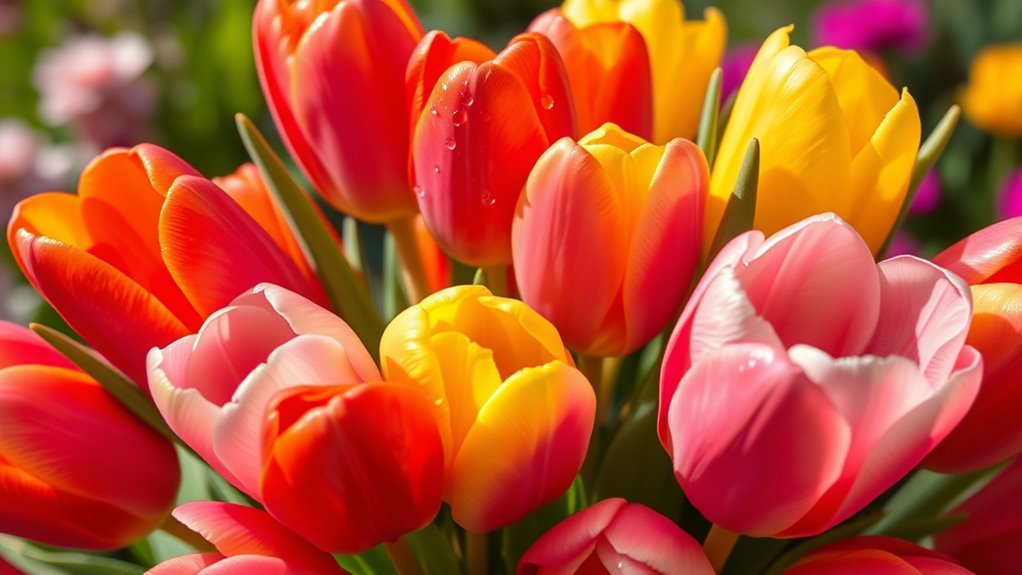
You’ll notice that the colors of tulips carry powerful messages, with each shade conveying different emotions. Bright reds symbolize love and passion, while soft pinks express hope and admiration. By understanding these hues, you can choose tulips that speak directly to your feelings of forgiveness or optimism. Additionally, selecting flowers with meaningful symbolism can enhance the emotional impact of your bouquet.
Color Symbolism in Tulips
Brightly colored tulips carry powerful messages through their hues, making them a popular choice for conveying hope and forgiveness. In botanical symbolism, floral color meanings reveal the emotions behind each shade. For instance, with tulips, the color you choose can express specific sentiments:
- Red symbolizes love and passion, conveying deep affection.
- Yellow signifies cheerful optimism and friendship.
- Pink reflects grace, admiration, and gentle hope.
- White represents purity, forgiveness, and new beginnings.
These vibrant hues communicate your feelings subtly yet effectively. Understanding floral color meanings helps you select the perfect tulip for any occasion, ensuring your bouquet sends the right message. Tulips’ botanical symbolism makes them ideal for expressing hope, forgiveness, and heartfelt emotions through their bright, meaningful colors. Additionally, considering the color symbolism of tulips can enhance your ability to convey nuanced messages through your floral arrangements.
Emotions Conveyed by Shades
Bright hues of tulips communicate powerful emotions that words often cannot capture, making them ideal for expressing hope and forgiveness. In flower symbolism in art, vibrant colors have long represented emotional depths that transcend verbal communication. When you choose bright tulips, you’re harnessing emotional expression through color, signaling renewal and reconciliation. Yellow tulips, in particular, convey cheerfulness and optimism, fostering a sense of hope. Pink tulips symbolize affection and forgiveness, helping mend strained relationships. These shades serve as visual cues that communicate sincerity and a desire for harmony. By selecting bright tulips, you send a message of positivity and renewal, tapping into the universal language of color that resonates deeply with emotional needs. Additionally, incorporating AI safety considerations can ensure that technology used in floral arrangements or messaging remains secure and trustworthy.
Daisies: Innocence, Purity, and New Beginnings

Daisies have long been associated with innocence and purity, making them a popular choice for expressing fresh beginnings. When incorporating daisies into your flower arrangement tips, consider their simplicity and cheerful appeal. Visualize a bouquet with:
- Bright white petals radiating joy and clarity
- Green foliage adding freshness and vibrancy
- A mix of wildflowers for a natural, rustic look
- Soft yellow centers symbolizing hope and optimism
Adding a touch of high suction power can help ensure that your arrangement stays pristine by gently removing dust and debris from delicate petals and leaves. These elements align with seasonal flower trends, emphasizing lightness and renewal. Daisies work beautifully in arrangements for new ventures, graduations, or to celebrate a fresh start. Keep the design simple to highlight their purity, and choose a container that complements their natural charm, reinforcing the message of innocence and new beginnings.
Orchids: Elegance, Luxury, and Rare Beauty
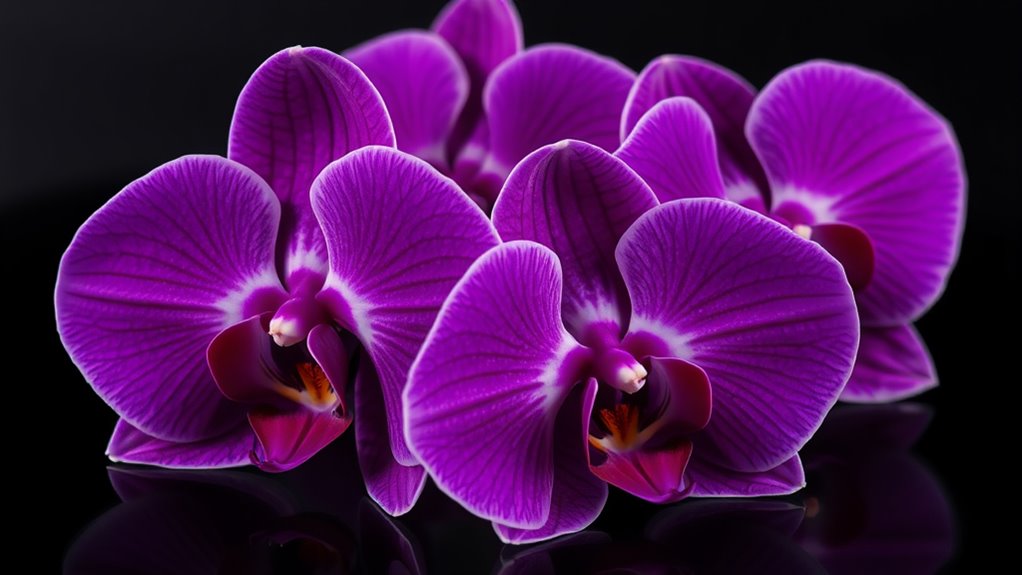
Orchids embody elegance and luxury, making them a mesmerizing choice for sophisticated floral arrangements. Their symbolic flower meanings often represent beauty, refinement, and strength, making them perfect for expressing admiration or love. In cultural flower symbolism, orchids hold special significance—symbolizing fertility in some Asian cultures and luxury in Western traditions. When giving orchids, you communicate a message of rare beauty and delicate strength. Their intricate blooms convey sophistication and exclusivity, making them ideal for special occasions or to honor someone with refined taste. Choosing orchids sends a powerful message beyond their stunning appearance, reflecting deeper cultural and personal meanings. Their elegance and symbolism make orchids a timeless and meaningful addition to any bouquet. Additionally, understanding flower symbolism can enhance the emotional impact of your floral gift, making it even more memorable.
Sunflowers: Happiness, Loyalty, and Positivity
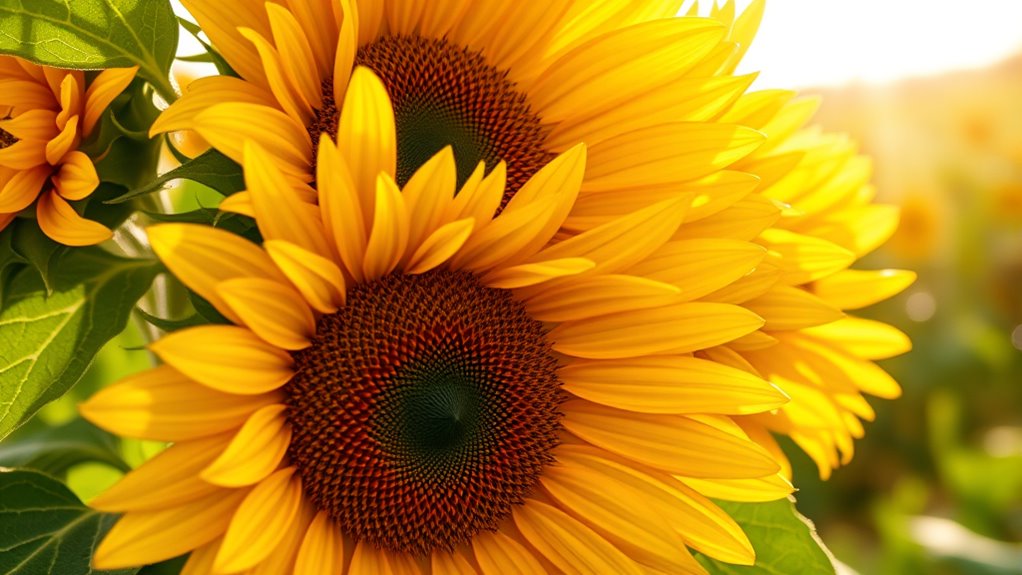
Sunflowers naturally draw attention with their bold, golden petals, making them a vibrant symbol of happiness and positivity. In botanical symbolism and floral language, they represent loyalty, admiration, and warmth. When you give or receive sunflowers, you’re expressing a message of unwavering support and joy. Imagine:
- Bright, sunflower fields stretching endlessly under a clear blue sky.
- The cheerful faces of sunflowers turning toward the sun, radiating optimism.
- A bouquet of sunflowers standing tall among greenery, symbolizing steadfast loyalty.
- A single sunflower in full bloom, capturing the essence of positivity and hope.
Their energetic appearance and meaningful floral language make sunflowers perfect for conveying your genuine good wishes, uplifting spirits, and celebrating loyalty with vibrant botanical symbolism. Understanding flower meanings can deepen your appreciation for the messages conveyed through floral arrangements.
Carnations: Deep Meaning and Their Use in Special Occasions

While sunflowers symbolize happiness and loyalty, other flowers carry deeper, more nuanced meanings suited for heartfelt occasions. Symbolic carnations, in particular, have a rich historical symbolism that makes them ideal for expressing admiration, love, or remembrance. These flowers are often used in bouquets for birthdays, anniversaries, or to honor loved ones. The specific color of carnations enhances their message: red for love, white for purity, and pink for gratitude. Understanding the deeper meaning behind symbolic carnations helps you communicate emotions subtly yet powerfully. Use this knowledge to select the perfect bouquet for any special occasion.
| Color | Meaning | Suitable Occasion |
|---|---|---|
| Red | Love and admiration | Anniversaries, romantic events |
| White | Purity and innocence | Weddings, sympathy |
| Pink | Gratitude | Thank-yous, appreciation |
| Purple | Capriciousness | Celebrations, surprise |
| Yellow | Friendship | Friendly gestures |
Forget-Me-Nots and Their Message of Remembrance
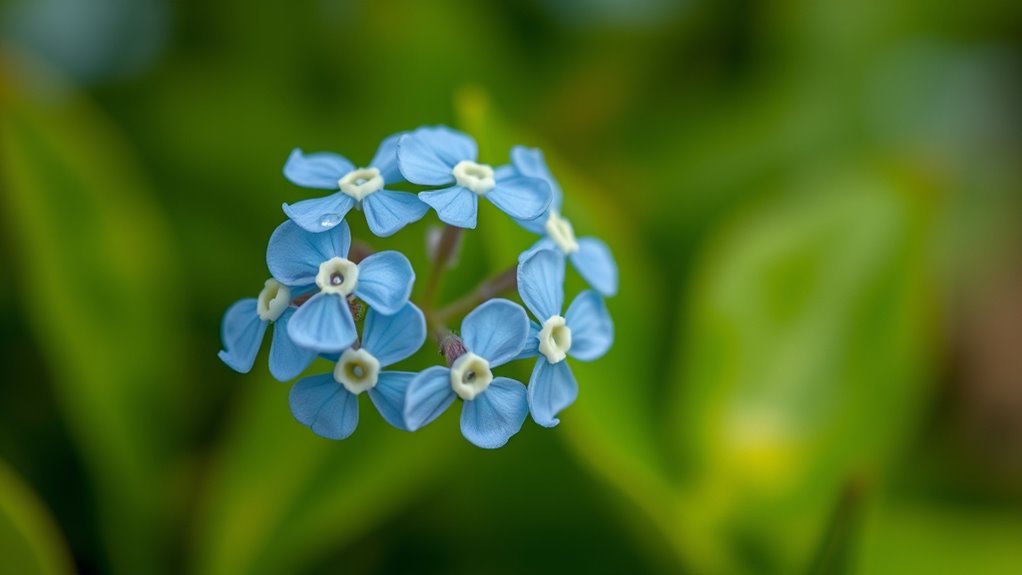
Forget-Me-Nots have long been cherished as symbols of remembrance and enduring love. Their flower symbolism in art often represents loyalty, memory, and true love. Historically, they hold significant meaning, dating back to medieval times when lovers exchanged these delicate blooms as tokens of fidelity. When you see a Forget-Me-Not, imagine:
- A heartfelt promise whispered beneath a moonlit sky
- A loved one’s memory preserved amid fading photographs
- A gentle reminder to cherish moments with those gone
- An enduring symbol of hope, even in loss
These tiny flowers carry a powerful message—reminding you to hold loved ones close and honor their memory. Their historical significance in art and culture cements their role as timeless tokens of remembrance.
Frequently Asked Questions
How Do Flower Colors Influence Their Symbolic Meanings?
You might wonder how flower colors influence their symbolic meanings. Flower color symbolism plays a significant role in conveying emotions and messages. Bright reds often symbolize love and passion, while soft pinks suggest admiration or sweetness. Yellow flowers symbolize friendship and happiness, and white signifies purity or innocence. The emotional associations of flowers depend heavily on their colors, allowing you to communicate your feelings effectively through thoughtful color choices in your bouquet.
Can Different Flower Species Have Conflicting Messages?
Conflicting messages can definitely arise from different flower species, creating confusion or mixed signals. When you combine diverse flower species in a bouquet, their symbolic meanings might clash—like love and rejection or friendship and farewell. You’re sending a layered message, so consider carefully. By understanding that different flower species can have conflicting messages, you can craft a bouquet that truly resonates with your intended sentiment, avoiding misunderstandings.
Are Flower Meanings Universal Across Cultures?
You might wonder if flower meanings are universal across cultures. The truth is, cultural symbolism and historical interpretations influence how flowers are understood worldwide. A flower that signifies love in one culture could symbolize mourning in another. So, when choosing flowers, consider the recipient’s background. You’ll guarantee your message is clear and respectful, avoiding misinterpretations caused by differing cultural symbolism and historical interpretations.
How Do Seasonal Flowers Affect Their Symbolism?
Seasonal flowers dramatically influence their symbolism, making your bouquet even more meaningful. When you choose flowers in season, they boast longer flower longevity, ensuring your message lasts. Plus, their floral scent significance is heightened, creating an aromatic experience that amplifies your emotions. You can’t ignore how seasonal blooms naturally embody the spirit of the moment, making your gesture more heartfelt and memorable than ever before.
Can Flower Arrangements Alter or Enhance Their Hidden Messages?
Your flower arrangement symbolism can definitely be altered or enhanced through thoughtful bouquet message customization. When you choose specific flowers and arrange them intentionally, you amplify the hidden messages they send. By customizing your bouquet, you control its symbolism, making it more personal and meaningful. This helps guarantee your message resonates clearly, allowing your flowers to communicate exactly what you want—whether love, gratitude, or celebration—more effectively than a generic arrangement.
Conclusion
Your bouquet is more than just flowers; it’s a vibrant story waiting to be told. As you choose blooms, imagine the whispered messages of love, hope, and remembrance they carry. Each petal, carefully selected, creates a tapestry of emotion, like sunlight dancing through leaves or a gentle breeze carrying heartfelt wishes. When you gift flowers, you’re sharing a silent language of feelings—beautiful, meaningful, and uniquely yours.
